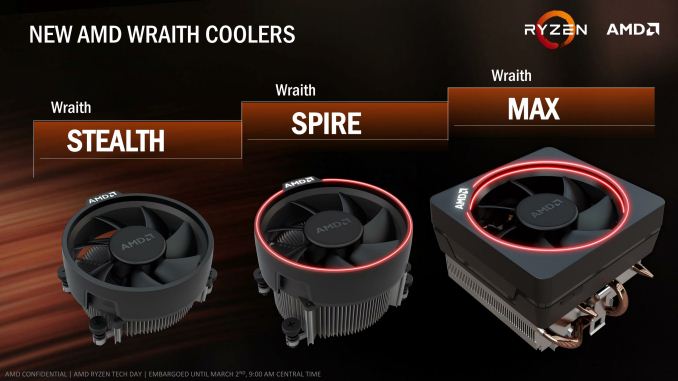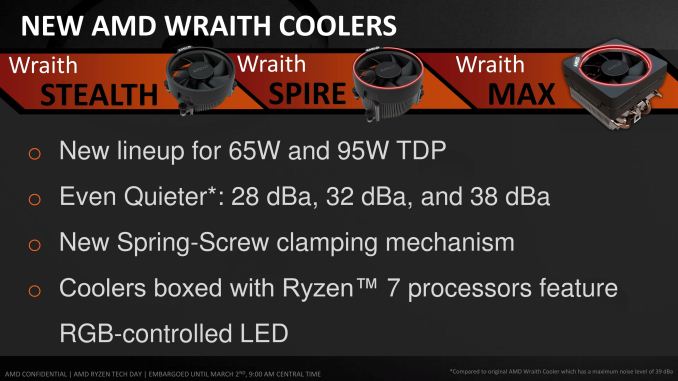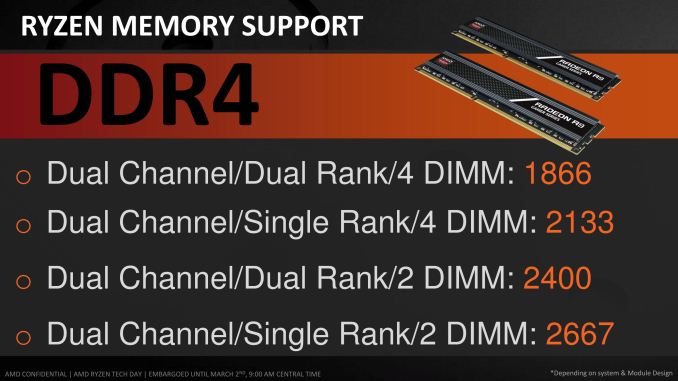The AMD Zen and Ryzen 7 Review: A Deep Dive on 1800X, 1700X and 1700
by Ian Cutress on March 2, 2017 9:00 AM ESTAMD Stock Coolers: Wraith v2
When AMD launched the Wraith cooler last year, bundled with the premium FX CPUs and highest performing APUs, it was a refreshing take on the eternal concept that the stock cooler isn’t worth the effort of using if you want any sustained performance. The Wraith, and the 125W/95W silent versions of the Wraith, were built like third party coolers, with a copper base/core, heatpipes, and a good fan. In our roundup of stock coolers, it was clear the Wraith held the top spot, easily matching $30 coolers in the market, except now it was being given away with the CPUs/APUs that needed that amount of cooling.
That was essentially a trial run for the Ryzen set of Wraith coolers. For the Ryzen 7 launch, AMD will have three models in play.
These are iterative designs on the original, with minor tweaks and aesthetic changes, but the concept is still the same – a 65W near silent design (Stealth), a 95W near silent design (Spire), and a 95W/125W premium model (Max). The 125W models come with an RGB light (which can be disabled), however AMD has stated that the premium model is currently destined for OEM and SI designs only. The other two will be bundled with the CPUs or potentially be available at retail. We have asked that we get the set in for review, to add to our Wraith numbers.
Memory Support
With every generation of CPUs, each one comes with a ‘maximum supported memory frequency’. This is typically given as a number, with the number aligning with the industry standard JEDEC sub-timings. Technically most processors will go above and beyond the memory frequency as the integrated memory controller supports a lot more; but the manufacturer only officially guarantees up to the maximum supported frequency on qualified memory kits.
The frequency, for consumer chips, is usually given as a single number no matter how many memory slots are populated. In reality when more memory modules are in play, it puts more strain on the memory controller so there is a higher potential for errors. This is why qualification is important – if the vendor has a guaranteed speed, any configuration for a qualified kit should work at that speed.
In the server market, a CPU manufacturer might list support a little differently – a supported frequency depending on how many memory modules are in play, and what type of modules. This arguably makes it very confusing when applied at a consumer level, but on a server level it is expected that OEMs can handle the varying degree of support.
For Ryzen, AMD is taking the latter approach. What we have is DDR4-2666 for the simplest configuration – one module per channel of single rank UDIMMs. This moves through to DDR4-1866 for the most strenuous configuration at two modules per channel with dual-rank UDIMMs. For our testing, we were running the memory at DDR4-2400, for lack of a fixed option, however we will have memory scaling numbers in due course. At present, ECC is not supported ECC is supported.













574 Comments
View All Comments
bobsta22 - Saturday, March 4, 2017 - link
Office with 20 PCs - all developers - loads of VMs and containers.All the PCs are due a CPU/Gfx refresh, but ITX mobos required.
Cant wait tbh. This is a game changer.
prisonerX - Saturday, March 4, 2017 - link
What if they come out with a 16 core line next year!bobsta22 - Saturday, March 4, 2017 - link
What?lilmoe - Tuesday, March 7, 2017 - link
It really is. As a freelance developer, I can't wait.ericgl21 - Saturday, March 4, 2017 - link
For me, the more important thing to see from AMD is if they can come up with a chip that can beat the mobile Core i7-7820HQ (4c/8t no ECC) & the Xeon E3-1575M v5 (4c/8t with ECC), for less money.And the number of PCIe gen3 lanes is very important, especially with the rise of M.2 NVMe storage sticks.
cmagic - Sunday, March 5, 2017 - link
Will anandtech review Ryzen in gaming? I would really like Anandtech view, since I don't really trust other sites especially those "entertainment" sites. Want to see how Anandtech dive into its main cause.Tchamber - Sunday, March 5, 2017 - link
@cmagicPage 15
2017 GPU
The bad news for our Ryzen review is that our new 2017 GPU testing stack not yet complete. We recieved our Ryzen CPU samples on February 21st, and tested in the hotel at the event for 6hr before flying back to Europe.
I just ordered my 1700X, I plan to keep it for at least 5 years, as my needs don't change much. My current Intel 6 core is coming up on 7 years old now. I like to buy high end and use it a long time.
Lazlo Panaflex - Monday, March 6, 2017 - link
Same here...probably gonna grab a 1700 at some point and put this here i5-2500 non-k in the kids computer.asH98 - Sunday, March 5, 2017 - link
'''The BIG QUESTION is WHY are the HEDT benchmarks (professional ie Blender) fairer than gaming benchmarks??Bottom line is that CUTTING-EDGE CODING is happening NOW in AI, HPC, data, and AV/AR, game coders because of $$$ are the last to change or learn unless forced (great for NVidia Intel) so most of the game coding is stuck in yesteryear- Bethesda will be the test bed for game coders to move forward
Hence the difference in game benchmarks vs 'professional' (HEDT) benchmarks. Game coders can get stuck using yesterday's code without repercussions and consequences as long as old hardware dominates and there are no incentives to change or learn new skills. The same Cant happen in the Professional area where speed is tantamount to performance and $$$
TheJian - Sunday, March 5, 2017 - link
I hope you're going to test a dozen games at 1080p where most of us run for article #2 and the GAMING article should come in a week not 1/2 year later like 1080/1070 gtx reviews...LOL. As this article just seems like AMD told you "guys, please don't run any games so we can sell some chips to suckers before they figure out games suck". And you listened. No point in testing 1440p or 4k for CPU, and 95% of us run 1920x1200 and BELOW so you should be testing your games there for a CPU test.The fact they are talking Zen2 instead of fixing Zen1 kind of makes me think most of the gaming is NOT going to be fixable.
http://www.legitreviews.com/amd-ryzen-7-1800x-1700...
149fps for 7700 in theif vs. 108 for 1800x? JEEZ. GTA5 again, 163 to 138. Deus ex MD 127 to 103. These are massive losses to Intel's chip and Deus was clearly gpu bound as many of Intel's chips hit the same 127fps including my old 4790k :( OUCH AMD.
https://www.guru3d.com/articles_pages/amd_ryzen_7_...
Tombraider same 7700k vs. 1800x 132fps to 114 (never mind 6850 scoring 140fps). This will probably get worse as we move to 1080ti, vega, nvidia refresh for xmas, Volta, 10nm etc. If you were using a faster gpu the cpus will separate even more especially if people are mostly gaming at 1080p. Even if many move to 1440p, that maybe fixes some games (tombraider is one with 1080 regular that hits a wall at 90fps), but again goes back to major losses as we move to 10nm etc. We get 10nm chips for mobile now and gpus probably next year at 12nm (real? fake 12nm? Either way) and might squeak into 2017 (volta, TSMC). 10nm gpus will likely come 2018 at the latest. Those gpus will make 1440p look like 1080p today surely and cpus will again spread out (and no, we won't all be running 4k then...LOL). You could see cpus smaller than 10nm BEFORE you upgrade your cpu again if you buy this year. That could get pretty ugly if the benchmarks around the web for gaming are not going to improve. One more point you'll likely be looking at GDDR6 (16Gbps probably) for vid cards allowing them to possibly stretch their legs even more if needed. Again, all not good for a gamer here IMHO.
“But Senior Engineer Mike Clark says he knows where the easy gains are for Zen 2, and they're already working through the list”
So maybe no fix in sight for Zen1? Just excuses like "run higher res, and code right guys"...I hope that isn't the best they've got. I could go on about games, but most should get the point. I was going to buy ryzen purely for Handbrake, but I'll need to see motherboard improvements and at least some movement on gaming VERY soon.
One more ouch statement from pcper.
https://www.pcper.com/news/Processors/AMD-responds...
"For buyers today that are gaming at 1080p, the situation is likely to remain as we have presented it going forward."
So they don't think a fix is coming based on AMD info and as noted as gpus get much faster (along with their memory speeds) expect 1440p to look like today's 1080p benchmarks at least to some extent.
The board part is of major interest to me, so I can wait a bit and also see Intel's response. So AMD has be hanging for a bit here, but not for too long. I do like the pro side of these though (handbrake especially, just not quite enough).